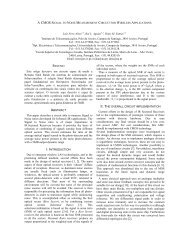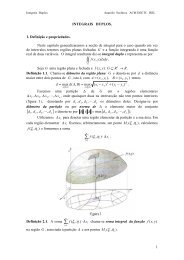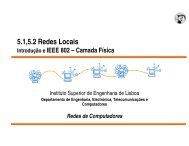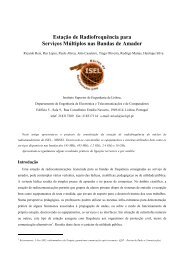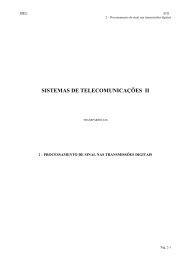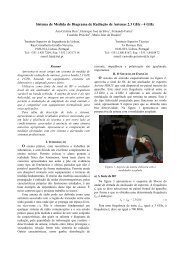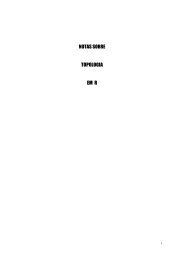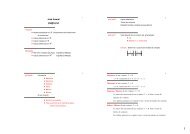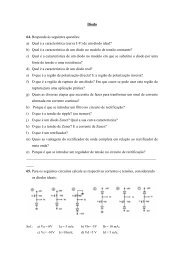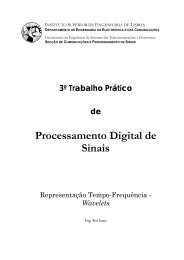Ficha de trabalho 9 (Integrais duplos.) - deetc
Ficha de trabalho 9 (Integrais duplos.) - deetc
Ficha de trabalho 9 (Integrais duplos.) - deetc
Create successful ePaper yourself
Turn your PDF publications into a flip-book with our unique Google optimized e-Paper software.
Instituto Superior <strong>de</strong> Engenharia <strong>de</strong> Lisboa - DEETC - Área Científica <strong>de</strong> Matemática<br />
1. Calcule os seguintes integrais<br />
Análise Matemática II - LEETC e LERCM<br />
<strong>Ficha</strong> <strong>de</strong> <strong>trabalho</strong> 9 (<strong>Integrais</strong> <strong>duplos</strong>.)<br />
a) 1 x<br />
0 x2 xy2 dy dx<br />
b) 3/2 3−y<br />
y dx dy<br />
1 y<br />
c) √ 2π x3 √ sin π 0 y<br />
dy dx x<br />
d) 1 x2 −1 −x2(x2 − y) dy dx<br />
2. Calcule os integrais <br />
D<br />
f(x, y) dx dy, sendo<br />
a) f(x, y) = x 2 e D a região limitada por xy = 16, x = y e x = 8.<br />
b) f(x, y) = e x2<br />
e D a região limitada por y = 2x, x = 1 e y = 0.<br />
c) f(x, y) = 1 e D a região limitada por y = x 2 e x = y 2 .<br />
d) f(x, y) = y e D a região limitada por x 2 + y 2 = 25 e x + y = 5.<br />
3. Usando uma mudança <strong>de</strong> coor<strong>de</strong>nadas conveniente calcule <br />
sendo:<br />
D<br />
f(x, y) dx dy,<br />
a) D = {(x, y) ∈ R2 : x + y ≤ 1, 0 ≤ y ≤ x} e f(x, y) = e−(x+y)4(x2 − y2 ).<br />
b) D = {(x, y) ∈ R 2 : x 2 + y 2 ≤ 1} e f(x, y) = e −(x2 +y 2 ) .<br />
c) D = {(x, y) ∈ R 2 : x 2 + y 2 ≤ 9, x ≥ 0, y ≥ 0} e f(x, y) = 9 − x 2 − y 2 .<br />
4. Inverta a or<strong>de</strong>m <strong>de</strong> integração em:<br />
a) 2 <br />
0<br />
√ x<br />
f(x, y) dy dx.<br />
0<br />
b) 4 8<br />
f(x, y) dx dy.<br />
0 2y<br />
ey c) 2<br />
0<br />
d) e<br />
1<br />
1<br />
ln x<br />
0<br />
f(x, y) dx dy.<br />
f(x, y) dy dx.<br />
1
e) 1 π/2<br />
f(x, y) dx dy.<br />
0 arcsin y<br />
f) 1<br />
0<br />
√ y<br />
y 2 f(x, y) dx dy.<br />
5. Usando uma mudança <strong>de</strong> coor<strong>de</strong>nadas conveniente calcule a massa da placa<br />
plana P supondo a <strong>de</strong>nsida<strong>de</strong> f(x, y) = 6x − 3.<br />
P = {(x, y) ∈ R 2 : x − 1 ≤ y ≤ x + 1, x 2 − 1 ≤ y ≤ x 2 }.<br />
6. Determine o centroi<strong>de</strong> da região<br />
R = {(x, y) ∈ R 2 : y ≥ x, x 2 + y 2 ≥ a, x 2 + y 2 ≤ b (a < b)}.<br />
7. Usando uma mudança <strong>de</strong> coor<strong>de</strong>nadas conveniente, calcule o momento <strong>de</strong> inércia<br />
polar duma placa plana D <strong>de</strong> <strong>de</strong>nsida<strong>de</strong> f(x, y), sendo<br />
D = {(x, y) ∈ R 2 : 0 ≤ x + y ≤ 2, y ≤ x ≤ y + 1}<br />
f(x, y) =<br />
e x+y<br />
(x 2 + y 2 )[1 + (x − y) 2 ] .<br />
8. Inverta a or<strong>de</strong>m <strong>de</strong> integração e calcule, usando coor<strong>de</strong>nadas polares, o valor do<br />
integral<br />
1 2−2y<br />
(x 2 + y 2 ) −3/2 dx dy.<br />
0<br />
1−y<br />
2




